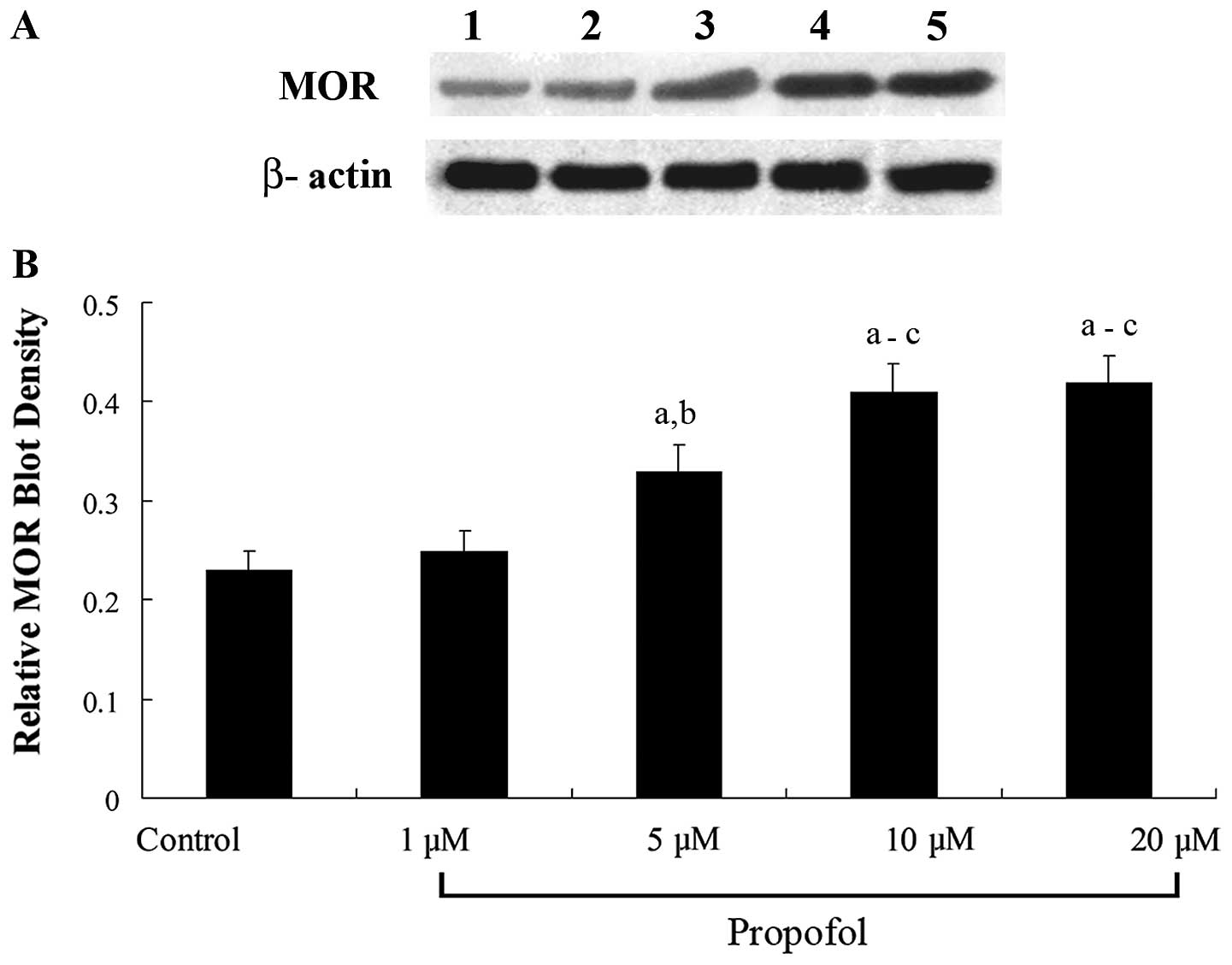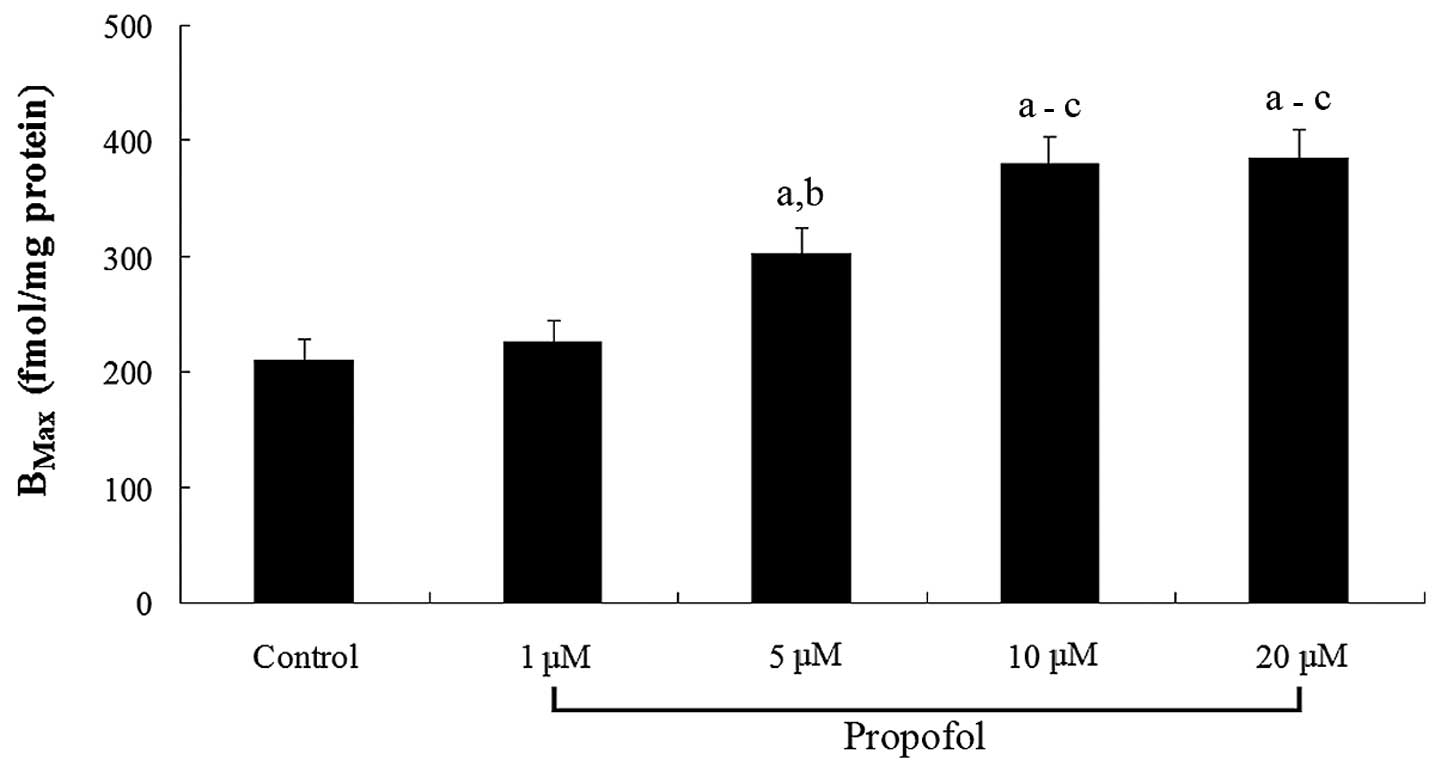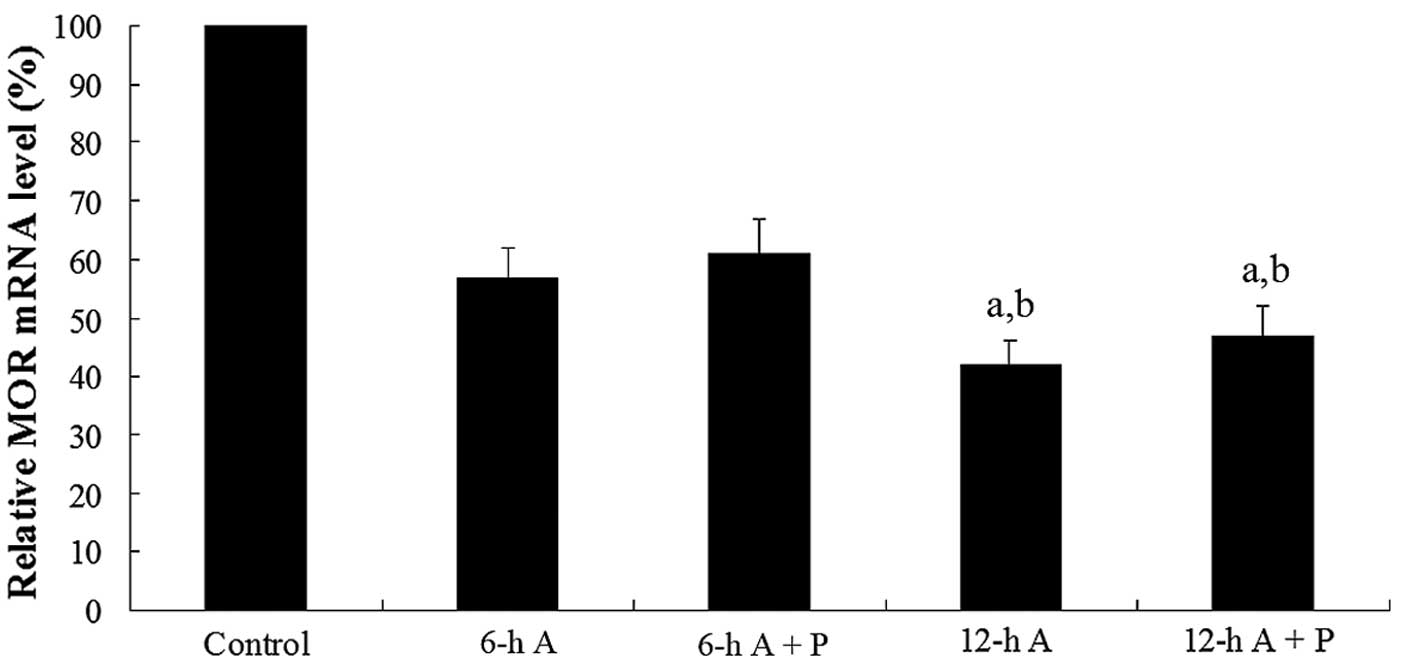Propofol increases µ-opioid receptor expression in SH-SY5Y human neuroblastoma cells
- Authors:
- Published online on: September 10, 2012 https://doi.org/10.3892/mmr.2012.1073
- Pages: 1333-1336
Abstract
Introduction
Propofol (2,6-diisopropylphenol) is a widely used intravenous sedative-hypnotic agent for the induction and maintenance of anesthesia and the sedation of critically ill patients (1). The advantages of this agent over others used for similar applications include a lower incidence of side effects (2) and improved quality of anesthesia (3). Although its clinical properties are well described, information concerning its potential for abuse has been slow to emerge. However, a growing body of literature has documented propofol abuse in humans and abuse-like behavior in animal models (4). Propofol directly activates the γ-aminobutyric acid (GABA) receptors and inhibits the N-methyl-D-aspartate (NMDA) receptor in the nervous system (5). Previous studies also showed that the μ-opioid receptor (MOR) is functionally linked to GABA (6,7) and NMDA receptors in neurons (8). The findings suggest a correlation between propofol and the MOR, however, this association has yet to be studied.
Opioid systems are critical in the modulation of pain behavior and antinociception. Opioid peptides and their receptors are expressed throughout the nociceptive neural circuitry and critical regions of the central nervous system (CNS) and are involved in the regulation of reward-seeking behavior and emotions (9). The opioid receptors μ, δ and κ have been cloned. The most commonly used opioids for pain management act on the MOR, which is expressed primarily in the CNS and contributes significantly to the regulation of opioid-induced analgesia, tolerance and dependence (10). In the present study, we explored for the first time the effect of propofol on MOR expression in a human neuronal cell line, aiming to reveal potentially new mechanisms underlying the effects of propofol as well as its potential for abuse.
Materials and methods
Reagents
Cell culture media and fetal calf serum were purchased from Invitrogen (Carlsbad, CA, USA). Actinomycin D, propofol and all other reagents were obtained from Sigma (St. Louis, MO, USA). The selective MOR ligand [3H]DAMGO was purchased from Perkin-Elmer (Waltham, MA, USA). TRIzol reagent for RNA isolation and the SYBR-Green I kit were purchased from Invitrogen and Roche Diagnostics (Indianapolis, IN, USA), respectively. Anti-MOR antibody (sc-7489) was purchased from Santa Cruz Biotechnology, Inc. (Santa Cruz, CA, USA). All secondary antibodies were obtained from Jackson ImmunoResearch Laboratories, Inc. (West Grove, PA, USA).
Cell culture and treatment
The SH-SY5Y human neuroblastoma cell line was purchased from the American Type Culture Collection (Manassas, VA, USA) and maintained in RPMI-1640 medium supplemented with 10% fetal bovine serum as previously described (11). The cells were treated with various concentrations of propofol (1, 5, 10 or 20 μM) for different time periods (6, 12 or 24 h). Propofol was dissolved in DMSO. Cells treated with DMSO were used as the control. The final concentration of DMSO in all samples was <0.3% (v/v). For actinomycin D treatment, the cells were pretreated with actinomycin D (1 mg/ml) for 30 min and then cultured for 12 or 24 h in medium containing actinomycin D (1 mg/ml) with or without propofol (10 μM).
Real-time quantitative RT-PCR
RNA was prepared using the TRIzol reagent followed by purification using a Turbo DNA-free kit (Ambion, Austin, TX, USA). cDNA was synthesized using SuperScript II reverse transcriptase (Invitrogen). Real-time quantitative PCR was performed using the LightCycler thermal cycler system (Roche Diagnostics) and the SYBR-Green I kit, following the manufacturer’s instructions. The results were normalized against those of the housekeeping gene glyceraldehyde-3-phosphate dehydrogenase (GAPDH) in the same sample. The primers used were: for human MOR, forward, 5′-CTGGGTCAACTTGTCCCACT-3′ and reverse, 5′-TGGACTAGAGGGCCAATGATC-3′; for human GAPDH, forward, 5′-GTCAGTGGTGGACCTGACCT-3′ and reverse, 5′-TGCTGTAGCCAAATTCGTTG-3′. The mRNA levels of the treated cells are shown as fold or percentage changes from those of the untreated control cells (designated as 1 or 100%). Each experiment was repeated three times in triplicate. Results were shown as the mean ± SD.
Western blot analysis
Immunoblotting was performed as previously described (12). Briefly, cells were dissolved in 250 μl of 2X SDS loading buffer (62.5 mM Tris-HCl, pH 6.8, 2% SDS, 25% glycerol, 0.01% bromophenol blue and 5% 2-mercaptoethanol), and incubated at 95°C for 10 min. Equal amounts of proteins from each sample were separated by 8% SDS-PAGE and blotted onto a polyvinylidene difluoride microporous membrane (Millipore, Billerica, MA, USA). The membranes were incubated for 1 h with a 1:1,000 dilution of anti-MOR antibody (sc-7489), washed and visualized using secondary antibodies conjugated with horseradish peroxidase (1:5,000, 1 h). Peroxidase was visualized with an ECL kit from GE Healthcare. The proteins were quantified prior to being loaded onto the gel and equal loading of extracts was verified by Ponceau staining.
μ-opioid receptor binding assay
SH-SY5Y cell membranes were prepared by homogenizing cells in 50 mM Tris-HCl buffer, pH 7.4, containing 1 mM EDTA, 1 mM dithiothreitol and 1 mM benzamidine, with a Polytron homogenizer. Following centrifugation (1,000 × g for 10 min at 4°C), supernatants were centrifuged (18,000 × g for 30 min at 4°C) and the pellets were resuspended in 50 mM Tris-HCl buffer, pH 7.4, containing 5 mM MgCl2. The protein concentrations were determined by bicinchoninic acid assay. For the saturation binding experiments, cell membranes (100 μg/assay) were incubated in 100 mM Tris-HCl, pH 7.4, containing 0.3% bovine serum albumin with increasing concentrations of [3H]DAMGO (0.1–5 nM). Non-specific binding was determined in the presence of DAMGO (10 μM). Following 90 min of incubation at 25°C, the bound ligand was isolated by rapid filtration on Whatman GF/B filters (Schleicher and Schuell, Riviera Beach, FL, USA). The filters were washed with 20 ml ice-cold 50 mM Tris-HCl buffer, pH 7.4, and left in scintillation fluid for 8 h prior to counting. Data were fitted by non-linear least-square regression and the Ligand program (13) was used to calculate receptor density (Bmax), Hill slopes and ligand affinity (Kd). Data are expressed as fmol of [3H]DAMGO bound and normalized to cell protein content. Each experiment was repeated three times in triplicate. Results are expressed as the mean ± SD.
Statistical analysis
Statistical analyses were performed with SPSS for Windows 10.0. Data values were shown as the mean ± SD. Comparisons of means among multiple groups were performed with one-way ANOVA followed by post hoc pairwise comparisons using the least significant difference method. The significance level of this study was set at two-sided α=0.05.
Results
SH-SY5Y cells were treated with various concentrations of propofol (1, 5, 10 or 20 μM) for different time periods (6, 12 or 24 h) and the endogenous MOR transcripts were evaluated using real-time quantitative RT-PCR. The MOR mRNA levels of the treated cells are shown as fold changes compared to those of the untreated control cells (designated as 1). At a concentration range of 1–10 μM, propofol increased the MOR mRNA levels in a statistically significant dose- and time-dependent manner within 12 h of treatment (Table I).
Western blot analyses revealed that propofol treatment for 12 h dose-dependently increased the MOR protein levels in the SH-SY5Y cells (Fig. 1). In cells treated for 12 h, propofol dose-dependently increased the MOR density (Bmax) in the cell membranes (Fig. 2). The results suggest that propofol significantly increases the density of ligand-binding MORs in the SH-SY5Y cell membranes by increasing the MOR mRNA levels.
To evaluate the effects of propofol on MOR mRNA stability, the SH-SY5Y cells were treated with the transcription inhibitor actinomycin D (14). By blocking transcription, we were able to determine whether propofol affects the stability of MOR mRNA. The cells were pretreated with actinomycin D (1 mg/ml) for 30 min and then cultured for 6 or 12 h in medium containing actinomycin D (1 mg/ml) with or without propofol (10 μM). Real-time quantitative RT-PCR assays showed that the MOR mRNA levels significantly decreased with time after actinomycin D treatment. In the presence of actinomycin D, propofol had no significant effect on the MOR mRNA levels over time (Fig. 3). The results suggest that propofol increases MOR expression at the transcriptional level, rather than enhancing the stability of MOR mRNA at the post-transcriptional level.
Discussion
In the present study, we have demonstrated that propofol is able to significantly increase MOR expression in SH-SY5Y human neuroblastoma cells at the transcriptional level, leading to an increased density of ligand-binding MORs in the cell membranes. This study provides the first evidence suggesting a functional link between propofol and the opioid system.
The actions of propofol and opioids are functionally linked with GABA and NMDA receptors in neurons (5–8). In this study, we used SH-SY5Y cells since they are human neuronal cells that endogenously express MORs as well as GABA and NMDA receptors (14–16), making them an excellent tool for an in vitro study concerning propofol’s effects on MOR expression and the underlying molecular mechanisms. Based on our findings, it would be of note to identify signaling pathways involved in the propofol-induced transcriptional regulation of the MOR gene in future studies.
Propofol dose- and time-dependently increases MOR expression (Table I) in neuronal cells, which results in an enhanced density of ligand-binding MORs in the cell membranes (Fig. 2). Thus, it is reasonable to suggest that long-term or frequent propofol sedation may potentiate the effects of endogenous μ-opioid peptides (e.g., endorphins and endomorphins) or μ-opioid analgesics (e.g., morphine and fentanyl), including side effects such as sedation, respiratory depression, euphoria and dependence. Significant experimental evidence suggests the endogenous opioid system (opioid peptides and receptors) with the development of dependence on a variety of drugs of abuse (17). Stimulation of the activity of distinct components of the endogenous opioid system by opioids or by other drugs of abuse, may mediate some of their reinforcing effects (17). Recent studies suggest that MOR and μ-opioid peptides are involved in the addictive processes induced by cannabinoids, nicotine and alcohol (18–20). Our findings suggest that by increasing MOR expression in neuronal cells, propofol has the potential to enhance the activity of the endogenous μ-opioid system and thus has the potential for abuse. A growing body of literature has documented propofol abuse in humans (4). The possibility of dependence and withdrawal is significant in determining propofol’s potential for abuse. Previous studies have suggested that propofol dependence and withdrawal is a phenomenon that is primarily observed in prolonged propofol use (21–25). Evidence suggests that chronic second-hand exposure to the aerosolized intravenous anesthetics propofol and fentanyl may cause sensitization and subsequent opiate addiction among anesthesiologists and surgeons (26). The molecular mechanism underlying propofol abuse is unknown. Based on our findings, we propose that propofol abuse following long-term or chronic propofol exposure may be partially attributable to propofol-induced MOR expression and that the combined use of propofol and opioid analgesics may enhance the development of opioid dependence and addiction.
In addition to being a widely used sedative-hypnotic agent, propofol is also known to be a potent, dose-dependent depressant of respiration (27). The mechanism by which propofol modulates the central respiratory network is not fully understood. According to our findings, the sedative and respiratory depression effects of propofol may be partially attributable to propofol-induced MOR expression during long-term or chronic use, which may enhance the activity of the endogenous μ-opioid system. Long-term or chronic use of propofol may also exacerbate the depression of respiration by μ-opioid analgesics. However, further studies are required to demonstrate the interaction between propofol and the opioid system at the systems biology level.
In conclusion, propofol dose- and time-dependently enhances MOR expression in SH-SY5Y human neuroblastoma cells at the transcriptional level, leading to an increased density of ligand-binding MORs in the cell membranes. This study demonstrates for the first time a link between propofol and the opioid system, thereby providing new insights into the propofol mechanism of action and potential for abuse.
References
|
Marik PE: Propofol: an immunomodulating agent. Pharmacotherapy. 25:S28–S33. 2005. View Article : Google Scholar | |
|
Tramèr M, Moore A and McQuay H: Propofol anaesthesia and postoperative nausea and vomiting: quantitative systematic review of randomized controlled studies. Br J Anaesth. 78:247–255. 1997.PubMed/NCBI | |
|
Schaer H: Propofol infusion for the maintenance of short-term anesthesia. Anaesthesist. 37:187–192. 1988.(In German). | |
|
Wilson C, Canning P and Caravati EM: The abuse potential of propofol. Clin Toxicol (Phila). 48:165–170. 2010. View Article : Google Scholar | |
|
Kotani Y, Shimazawa M, Yoshimura S, Iwama T and Hara H: The experimental and clinical pharmacology of propofol, an anesthetic agent with neuroprotective properties. CNS Neurosci Ther. 14:95–106. 2008. View Article : Google Scholar : PubMed/NCBI | |
|
Kalyuzhny AE, Dooyema J and Wessendorf MW: Opioid- and GABA(A)-receptors are co-expressed by neurons in rat brain. Neuroreport. 11:2625–2628. 2000. View Article : Google Scholar : PubMed/NCBI | |
|
Zhang G, Chen W and Marvizón JC: Src family kinases mediate the inhibition of substance P release in the rat spinal cord by μ-opioid receptors and GABA(B) receptors, but not α2 adrenergic receptors. Eur J Neurosci. 32:963–973. 2010.PubMed/NCBI | |
|
Mao J: NMDA and opioid receptors: their interactions in antinociception, tolerance and neuroplasticity. Brain Res Brain Res Rev. 30:289–304. 1999. View Article : Google Scholar : PubMed/NCBI | |
|
Al-Hasani R and Bruchas MR: Molecular mechanisms of opioid receptor-dependent signaling and behavior. Anesthesiology. 115:1363–1381. 2011.PubMed/NCBI | |
|
Mayer P and Höllt V: Pharmacogenetics of opioid receptors and addiction. Pharmacogenet Genomics. 16:1–7. 2006. View Article : Google Scholar : PubMed/NCBI | |
|
Di Toro R, Baiula M and Spampinato S: Expression of the repressor element-1 silencing transcription factor (REST) is influenced by insulin-like growth factor-I in differentiating human neuroblastoma cells. Eur J Neurosci. 21:46–58. 2005.PubMed/NCBI | |
|
Zhang Y, Wang D, Johnson AD, Papp AC and Sadée W: Allelic expression imbalance of human mu opioid receptor (OPRM1) caused by variant A118G. J Biol Chem. 280:32618–32624. 2005. View Article : Google Scholar : PubMed/NCBI | |
|
Munson PJ and Rodbard D: Ligand: a versatile computerized approach for characterization of ligand-binding systems. Anal Biochem. 107:220–239. 1980. View Article : Google Scholar : PubMed/NCBI | |
|
Guarino G and Spampinato S: Nandrolone decreases mu opioid receptor expression in SH-SY5Y human neuroblastoma cells. Neuroreport. 19:1131–1135. 2008. View Article : Google Scholar : PubMed/NCBI | |
|
Petroni D, Tsai J, Mondal D and George W: Attenuation of low dose methylmercury and glutamate induced-cytotoxicity and tau phosphorylation by an N-methyl-D-aspartate antagonist in human neuroblastoma (SHSY5Y) cells. Environ Toxicol. Oct 5–2011.(Epub ahead of print). View Article : Google Scholar | |
|
Massone S, Vassallo I, Fiorino G, et al: 17A, a novel non-coding RNA, regulates GABA B alternative splicing and signaling in response to inflammatory stimuli and in Alzheimer disease. Neurobiol Dis. 41:308–317. 2011. View Article : Google Scholar : PubMed/NCBI | |
|
Gianoulakis C: Endogenous opioids and addiction to alcohol and other drugs of abuse. Curr Top Med Chem. 4:39–50. 2004. View Article : Google Scholar : PubMed/NCBI | |
|
López-Moreno JA, López-Jiménez A, Gorriti MA and de Fonseca FR: Functional interactions between endogenous cannabinoid and opioid systems: focus on alcohol, genetics and drug-addicted behaviors. Curr Drug Targets. 11:406–428. 2010.PubMed/NCBI | |
|
Berrendero F, Robledo P, Trigo JM, Martín-García E and Maldonado R: Neurobiological mechanisms involved in nicotine dependence and reward: participation of the endogenous opioid system. Neurosci Biobehav Rev. 35:220–231. 2010. View Article : Google Scholar : PubMed/NCBI | |
|
Ray LA, Barr CS, Blendy JA, Oslin D, Goldman D and Anton RF: The role of the Asn40Asp polymorphism of the mu opioid receptor gene (OPRM1) on alcoholism etiology and treatment: a critical review. Alcohol Clin Exp Res. 36:385–394. 2012. View Article : Google Scholar : PubMed/NCBI | |
|
Carrasco G, Molina R, Costa J, Soler JM and Cabré L: Propofol vs midazolam in short-, medium-, and long-term sedation of critically ill patients: a cost-benefit analysis. Chest. 103:557–564. 1993. View Article : Google Scholar : PubMed/NCBI | |
|
Miller LJ and Wiles-Pfeifler R: Propofol for the long-term sedation of a critically ill patient. Am J Crit Care. 7:73–76. 1998.PubMed/NCBI | |
|
Boyle WA, Shear JM, White PF and Schuller D: Long-term sedative infusion in the intensive care unit: propofol vs midazolam. J Drug Dev. 4(Suppl): S43–S45. 1991. | |
|
Cammarano WB, Pittet JF, Weitz S, Schlobohm RM and Marks JD: Acute withdrawal syndrome related to the administration of analgesic and sedative medications in adult intensive care unit patients. Crit Care Med. 26:676–684. 1998. View Article : Google Scholar : PubMed/NCBI | |
|
Au J, Walker S and Scott DHT: Withdrawal syndrome after propofol infusion. Anaesthesia. 45:741–742. 1990. View Article : Google Scholar : PubMed/NCBI | |
|
McAuliffe PF, Gold MS, Bajpai L, et al: Second-hand exposure to aerosolized intravenous anesthetics propofol and fentanyl may cause sensitization and subsequent opiate addiction among anesthesiologists and surgeons. Med Hypotheses. 66:874–882. 2006. View Article : Google Scholar | |
|
Kashiwagi M, Osaka Y, Onimaru H and Takeda J: Optical imaging of propofol-induced central respiratory depression in medulla-spinal cord preparations from newborn rats. Clin Exp Pharmacol Physiol. Jan 19–2011.(Epub ahead of print). View Article : Google Scholar |












